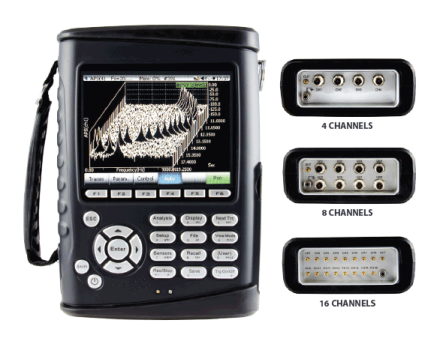MODAL TESTING
Modal testing is a common method of characterizing the vibrations of a structure by imparting a known force and measuring the response of the structure. By measuring both the input to the structure and the response, the frequency response of the structure can be calculated. Calculating the frequency response over multiple locations, either simultaneously or individually, will yield data that can be used to estimate the dynamic response of the structure.
The scale of a modal test can vary greatly. Test structures can be as small as silicon wafers used in electronics, and as large as multistory industrial sifters used at rock quarries. The size and geometry of the test structure will play a role is choosing how to excite it. The two most common methods are impact testing using a modal hammer and shaker testing.
After collection, the data can be processed using ME’scope, a popular modal analysis software from Vibrant Technologies. The result of the measurements and processing would be an animated model of the operating deflection shapes (ODS) that clearly illustrates the movement of the structure. Most commonly, these models are analyzed to identify modal frequencies.
At these frequencies the structure vibrates with minimal input energy. Exciting the structure at these frequencies can easily cause damage to the system. Characterizing the response of the structure mean that the design can be changed to reduce the response, or the operating conditions can be adjusted to avoid failures.
(For step-by-step instructions on how to conduct modal testing on the CoCo instruments, click here to download the CoCo Modal Data Acquisition Operation Manual.)
Impact Hammer Modal Testing
A typical impact test will use an impact modal hammer and a response accelerometer. It is important to consider the scale of the test structure when selecting these sensors. The impact hammer imparts an impulse force into the system and is intended to excite a broad bandwidth. The Impact hammers range in size, sensitivity, and hardness depending on the scale of the system they need to excite and the bandwidth of interest. Similarly, the response accelerometer needs to be sensitive enough to detect the ringing of the structure without saturating. The output of the impact hammer and accelerometer are used to calculate the frequency response functions (FRFs) across the structure.
It is usually easier to mount the accelerometer in a single location and vary the impact location. This type of test is referred to as a ‘roving impact’ modal test. It is important to carefully plan and document the impact locations for the test. This information is crucial when piecing together the individual FRFs to analyze the response of the structure as a whole. Third party software packages, such as Vibrant Technology’s ME’scope, can use the FRF and location data to animate a computer model. These animations help to clearly visualize the operating deflection shapes (ODSs) of the structure.




